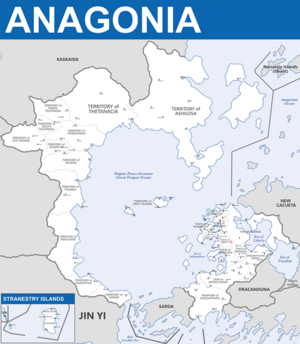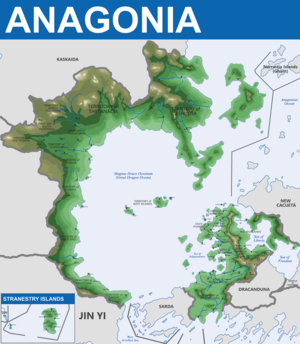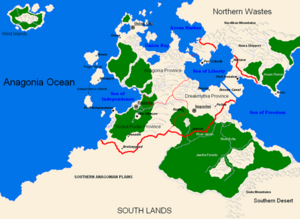Anagonia: Difference between revisions
Tag: Manual revert |
Tag: Manual revert |
||
| Line 100: | Line 100: | ||
==History== | ==History== | ||
{{main|History of Anagonia & | {{main|History of Anagonia & Its People}} | ||
==Etymology== | ==Etymology== | ||
Revision as of 01:10, 23 April 2024
This article is incomplete because it is pending further input from participants, or it is a work-in-progress by one author. Please comment on this article's talk page to share your input, comments and questions. Note: To contribute to this article, you may need to seek help from the author(s) of this page. |
The Confederate States of Anagonia Anagonia | |
|---|---|
Motto: "Astra inclinant, sed nonobligant" (The stars incline, but do not oblige) | |
Anthem: "My Country! 'Tis Of Thee" (Adopted July 14th, 104 AUR by Grand Congress vote) | |
 | |
| Capital | Liberty City |
| Largest city | Atlantica |
| Official languages | Native Anagonian & English |
| Recognised regional languages | Regional dialects dependent on State or Territory |
| Other languages | (Other European, Russian, Spanish, Other Asian, Various Non-Human Languages) |
| Ethnic groups (108 AUR) | Anagonian, Various others determined on state and territory |
| Demonym(s) | Anagonian(s), Confederate(s) |
| Government | Confederal Presidential Republic |
• President | Mileethus Canisilus |
• Vice President | Franklin Johnson |
| Establishment | |
• XX | XX |
• XX | XX |
• XX | XX |
• XX | XX |
• XX | XX |
• XX | XX |
| Area | |
• Total | 21,864,400 km2 (8,441,900 sq mi) |
| Population | |
• 108 AUR estimate | 450,522,407 |
• Density | 5.77/km2 (14.9/sq mi) |
| GDP (nominal) | 108 AUR estimate |
• Total | D$28,424,257,741,025 |
• Per capita | D$78,246.01 |
| Gini | 0.43 low |
| HDI | 0.927 very high |
| Currency | Confederate DENAR (D$) |
| Time zone | UTC+5 (Anagonian Standard Time Zones) |
• Summer (DST) | UTC+6 (Anagonian Standard Time Zones) |
| Driving side | right |
| Calling code | 678 |
| Internet TLD | .CSA |
The Confederate States of Anagonia has:
| |
Introduction
Anagonia, officially the Confederate States of Anagonia, is a large nation that exists within the region of Esvanovia renowned for its rich cultural heritage, diverse landscapes, and vibrant biodiversity which includes non-human sapient life. Situated around the heart of the Anagonian Ocean and on two continential landmasses, Anagonia spans approximately 21,864,400 square kilometers, encompassing a primary territorial claim which surrounds the majestic Magnus Draco Oceanum, also known as the Great Dragon Ocean. The nation's territory is divided between the continents of Minor Kistavich, where the mainland is located, and Major Kistavich, which hosts the rest of the Territories across the Great Dragon Ocean.
Home to seven states—Lexington, Plymouth, Arkansis, Orgath, Liberty, Saratoga, and Imperius—and sixteen territories—West Islands, Wildlands, Ashilosa, Thetanacia, North Teustredia, South Teustredia, Thireatheria, Che Traman, Duderlia, Whiana, Thuaria, Arkleland, Hamotichia, Sarder, Wildlantaria, and the Stranestry Islands—Anagonia boasts a rich tapestry of cultural traditions and historical significance. Each state and territory contributes to the nation's unique identity, with distinct landmarks, festivals, and customs that reflect its heritage. Several non-human semi-sapient wildlife and non-human sapient citizens call these lands and territories home.
With its captivating scenery, fascinating wildlife and citizenry, and vibrant communities, Anagonia as a whole is a land of endless exploration and discovery which draws in visitors from far and wide to experience its wonders firsthand.
History
Etymology
The etymology of "Anagonia" intertwines with the ancient history and cultural tapestry of the land, reflecting the diverse influences that have shaped its meaning over time. At the heart of this etymology lies the intersection of two distinct cultures: the Seurians, akin to the Anglo-Saxons, and the indigenous Anagonians.
Historians, archeologists, and etymologists all agree that the native language of modern Anagonians and their unique name must derive from some experience with the Seurians prior to 6967 BCE.
Around 400 BCE, it was historically recorded both in ancient texts and archeological findings that Ancient Seuria, the ancient homeland of the Seurians on the continent of Major Kistavich, waged a violent war against the Anagonian people and her neighbors under the leadership of the Ancient Seurian known as "Oisean Macmathan". Rikor Hak, the well-known Second Disciple of Melkos, has well preserved journals and written texts on his and his armies experiences in fending off the "Seurian Empire".
It is through these journals, texts, and recorded historical events that etymologists have been able to conclude that Seuria played a heavy role in Anagonian language syntax and development. Seuria, which in modern day exists as a diminished island nation north of nations of Arcadie and Kaskaida and resides in the Northern Ocean, has had long-lasting cultural, linguistic, and other influences on Anagonian culture.
The supposed prefix "Ana-" and suffix "-gonia" further enrich the meaning of "Anagonia." The prefix "Ana-" could potentially denote a sense of primordial or native essence, suggesting an origin deeply rooted in the land itself. Meanwhile, the suffix "-gonia" commonly denotes a land or territory, implying that Anagonia is not just a place but a distinct realm imbued with its own unique character and significance. Together, these linguistic elements encapsulate the essence of Anagonia as a land of ancient heritage, mythical connections, and enduring legacy.
The name "Anagonia" carries echoes of both Seurian and Anagonian heritage. Through meticulous research and lore, it has been deciphered to translate as "Native Dragon Man," offering insight into the ancestral relationship between the Anagonians and the mythical dragons that roamed their land. This interpretation suggests a profound connection between the indigenous people and the awe-inspiring creatures that inhabited their midst. It also supposed that perhaps at one point, the word "Anagonia" could have used by Seurians as an identifier to what an Anagonian could have been before their name.
The term "Dragon Man" within the context of Anagonia evokes images of a society intertwined with the mythos of dragons, perhaps revered as guardians or spiritual beings. It speaks to a time when dragons may have played a significant role in the lives and legends of the Anagonian people, shaping their culture, beliefs, and even their very identity. Thus, "Anagonia" serves as a testament to the enduring bond between Anagonia and the mystical realm of dragons, a bond woven deep into the fabric of Anagonian history and lore, and a bond that persist to Modern Day as Anagonians continue pilgrimages to see their dragon kin.
Geography and Climate
Anagonia, a vast and diverse nation spanning approximately 21,864,400 square kilometers, boasts a varied landscape characterized by rugged mountains, sweeping plains, and coastal regions. With its mainland and capital situated southeast of the heart of the Anagonian Ocean, the nation itself encompasses and surrounds the magnificent Magnus Draco Oceanum, also known as the Great Dragon Ocean, which serves as the centerpiece of the nation's geography via its vast expanse.
Geography

Image circa 108 AUR
NOTE POST-GREAT WAR CHANGES:
* More Territory to Southwest of Mainland
* Annexation of Additional Islands
* Annexation of Conquered Kaskaida Territories
Anagonia's mainland is delineated by the continents of Minor Kistavich and Major Kistavich, with the Great Dragon Ocean occupying the central expanse. The northern territories, including Ashilosa, Thetanacia, North Teustredia, South Teustredia, and Thireatheria, are dominated by mountainous terrain that gradually slopes downward into steppes, grasslands, and marshlands as they approach the Great Dragon Ocean. To the west, the Territories of Che Traman, Duderlia, Whiana, Thuaria, Arkleland, Hamotichia, and Sarder feature similar mountainous landscapes that give way to coastal plains along the shores of the Great Dragon Ocean.
In the western reaches of the nation lie the remnants of a sunken continent, now known as the West Islands, serving as a testament to ancient geological upheavals. The Stranestry Islands, located south of the Territory of Sarder in the West Arvolken Sea, offer a contrasting landscape with their gentle slopes and favorable weather conditions. To the east, mainland Anagonia transitions from the independent nation of Sarda to the Sovereign Nation of Nodea Rudav and the Imperial Drekamythian Empire, culminating in the peninsula-like mass of Anagonia proper.
The mainland of Anagonia, which is situated southeast of the Great Dragon Ocean on the continent of Minor Kistavich, is further divided into seven states: Lexington, Plymouth, Orgath, Liberty, Saratoga, Imperius, and Arkansis. The State of Saratoga and the State of Plymouth lay claim to three large islands in the Sea of Independence, providing strategic access to the Great Dragon Ocean.

(circa United Republic era - 1921 AD & prior)
NOTE THE THREE DISTINCT PROVINCES:
* Anagonia Province
* Drekamythia Province
* Nodea Rudav Province
The United Republic of Anagonia was a more federalized entity that combined the mainland Anagonia into one primary nation. It would eventually fall due to civil war in 1921 AD.
Climate
Anagonia experiences a diverse range of climates due to its expansive geography and varied topography. The northern territories are characterized by a continental climate, with cold winters and warm summers, while the coastal regions benefit from milder temperatures moderated by oceanic influences.
In the mountainous regions, precipitation is abundant, resulting in lush forests and verdant valleys. The western territories receive ample rainfall, fostering fertile soils ideal for agriculture and supporting diverse ecosystems. In contrast, the eastern reaches of Anagonia, bordering the Imperial Drekamythian Empire and the Sovereign Nation of Nodea Rudav, experience somewhat drier conditions, with semi-arid climates prevailing in some areas. However this is diversified within the mainland of Anagonia in its primary states. They experiences a wide verity of temperate-to-dry conditions year-round which support a wide variety of agricultural and biological diversity, with mild winters typically thanks to warmer currents flowing from the north.
The coastal regions, including the Territories of Che Traman, Duderlia, Whiana, Thuaria, Arkleland, Hamotchia, and Sarder, enjoy mostly temperate climates characterized by mild winters and moderate summers. The Stranestry Islands boast favorable weather conditions year-round, making them popular destinations for tourists and travelers seeking relaxation and tranquility.
Overall, Anagonia's climate and geography contribute to its rich biodiversity and cultural diversity, making it a land of endless exploration and discovery.


